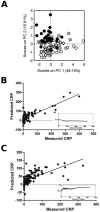The impact of inflammation on metabolomic profiles in patients with arthritis
- PMID: 23740368
- PMCID: PMC3840700
- DOI: 10.1002/art.38021
The impact of inflammation on metabolomic profiles in patients with arthritis
Abstract
Objective: Inflammatory arthritis is associated with systemic manifestations including alterations in metabolism. We used nuclear magnetic resonance (NMR) spectroscopy-based metabolomics to assess metabolic fingerprints in serum from patients with established rheumatoid arthritis (RA) and those with early arthritis.
Methods: Serum samples were collected from newly presenting patients with established RA who were naive for disease-modifying antirheumatic drugs, matched healthy controls, and 2 groups of patients with synovitis of ≤3 months' duration whose outcomes were determined at clinical followup. Serum metabolomic profiles were assessed using 1-dimensional (1) H-NMR spectroscopy. Discriminating metabolites were identified, and the relationships between metabolomic profiles and clinical variables including outcomes were examined.
Results: The serum metabolic fingerprint in established RA was clearly distinct from that of healthy controls. In early arthritis, we were able to stratify the patients according to the level of current inflammation, with C-reactive protein correlating with metabolic differences in 2 separate groups (P < 0.001). Lactate and lipids were important discriminators of inflammatory burden in both early arthritis patient groups. The sensitivities and specificities of models to predict the development of either RA or persistent arthritis in patients with early arthritis were low.
Conclusion: The metabolic fingerprint reflects inflammatory disease activity in patients with synovitis, demonstrating that underlying inflammatory processes drive significant changes in metabolism that can be measured in the peripheral blood. The identification of metabolic alterations may provide insights into disease mechanisms operating in patients with inflammatory arthritis.
© 2013 The Authors. Arthritis & Rheumatism is published by Wiley Periodicals, Inc. on behalf of the American College of Rheumatology.
Figures



References
-
- Cederholm T, Wretlind B, Hellstrom K, Andersson B, Engstrom L, Brismar K, et al. Enhanced generation of interleukins 1β and 6 may contribute to the cachexia of chronic disease. Am J Clin Nutr. 1997;65:876–82. - PubMed
-
- Kotler DP. Cachexia. Ann Intern Med. 2000;133:622–34. - PubMed
-
- Brindle JT, Antti H, Holmes E, Tranter G, Nicholson JK, Bethell HW, et al. Rapid and noninvasive diagnosis of the presence and severity of coronary heart disease using 1H-NMR-based metabonomics. Nat Med. 2002;8:1439–44. - PubMed
-
- Sitton NG, Dixon JS, Bird HA, Wright V. Serum biochemistry in rheumatoid-arthritis, seronegative arthropathies, osteoarthritis, SLE and normal subjects. Br J Rheumatol. 1987;26:131–5. - PubMed
-
- Sitton NG, Dixon JS, Bird HA, Wright V. Serum and synovial fluid histidine: a comparison in rheumatoid arthritis and osteoarthritis. Rheumatol Int. 1986;6:251–4. - PubMed
Publication types
MeSH terms
Substances
Grants and funding
LinkOut - more resources
Full Text Sources
Other Literature Sources
Medical
Research Materials

